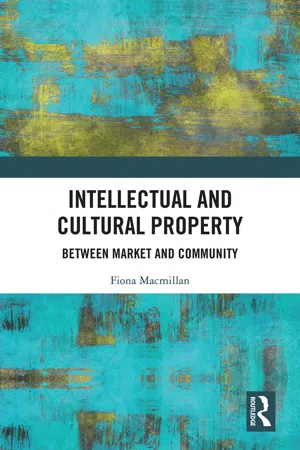
- 256 pages
- English
- ePUB (mobile friendly)
- Available on iOS & Android
About This Book
This book focuses on the fraught relationship between cultural heritage and intellectual property, in their common concern with the creative arts.
The competing discourses in international legal instruments around copyright and intangible cultural heritage are the most obvious manifestation of this troubled encounter. However, this characterization of the relationship between intellectual and cultural property is in itself problematic, not least because it reflects a fossilized concept of heritage, divided between things that are fixed and moveable, tangible and intangible. Instead the book maintains that heritage should be conceived as part of a dynamic and mutually constitutive process of community formation. It argues, therefore, for a critically important distinction between the fundamentally different concepts of not only intellectual and cultural heritage/property, but also of the market and the community. For while copyright as a private property right locates all relationships in the context of the market, the context of cultural heritage relationships is the community, of which the market forms a part but does not – and, indeed, should not – control the whole. The concept of cultural property/heritage, then, is a way of resisting the reduction of everything to its value in the market, a way of resisting the commodification, and creeping propertization, of everything. And, as such, the book proposes an alternative basis for expressing and controlling value according to the norms and identity of a community, and not according to the market value of private property rights.
An important and original intervention, this book will appeal to academics and practitioners in both intellectual property and the arts, as well as legal and cultural theorists with interests in this area.
Frequently asked questions
Information
Chapter 1
Copyright and cultural production
1 Introduction
1.1 The Fall of Icarus and the burden of genius
had suspected Icarus of being a fortress taken by Wallenstein in the Thirty Years’ War, but he was more than satisfied with the execution of the work, which was proclaimed by all who had the privilege of seeing it as Pincini’s masterpiece.3
[H]e bore on his back the burden of the dead man’s genius. On presenting himself one day in the steaming corridor of a vapour bath, he was at once hustled back into his clothes by the proprietor, who was a North Italian, and who emphatically refused to allow the celebrated Fall of Icarus to be publicly on view without the permission of the municipality of Bergamo. Public interest and official vigilance increased as the matter became more widely known, and Deplis was unable to take a simple dip in the sea or river on the hottest afternoon unless clothed up to the collar-bone in a substantial bathing garment. Later on the authorities of Bergamo conceived the idea that salt water might be injurious to the masterpiece, and a perpetual injunction was obtained which debarred the muchly harassed commercial traveller from sea bathing under any circumstances. Altogether, he was fervently thankful when his firm of employers found him a new range of activities in the neighbourhood of Bordeaux. His thankfulness, however, ceased abruptly at the Franco-Italian frontier. An imposing array of official force barred his departure, and he was sternly reminded of the stringent law which forbids the exportation of Italian works of art.4
1.2 Structure of the book
Table of contents
- Cover
- Half Title
- Title Page
- Copyright Page
- Dedication
- Table of Contents
- Preface
- List of abbreviations
- 1 Copyright and cultural production
- 2 Hyperreality and the non-propertized domain of intellectual space
- 3 Heritage, law and community
- 4 Community and cultural property
- 5 The monumental occidental tragedy
- 6 Explorations in the cultural landscape – arts festivals
- 7 Living between market and community
- Index